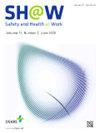Trends in Exposure to Respirable Dust and Respirable Crystalline Silica Among Lithium Mine Workers in Western Australia
IF 2.9
3区 医学
Q1 PUBLIC, ENVIRONMENTAL & OCCUPATIONAL HEALTH
引用次数: 0
Abstract
Background
Exposure to respirable dust (RES) and respirable crystalline silica (RCS) is common in mining operations and is associated with health effects such as pneumoconiosis, chronic obstructive pulmonary disease (COPD), interstitial pulmonary fibrosis, silicosis, lung cancer, and renal disease.
Methods
This study used industry occupational exposure data for respirable dust from two surface lithium mines in Western Australia for the period between 2017 and 2023. A total of 1122 samples were collected in workgroups across four departments - administration and support, mining, crushing and processing, and maintenance.
Results
The study found that the overall RES concentration did not exceed the exposure standard. However, Crusher Dry/Wet Plant Personnel (0.558 mg/m3) and Workshop Boilermakers (0.842 mg/m3) recorded elevated exposure to RES. The highest mean exposures for RCS over the seven-year study period were measured for Management Administration & Technical (0.068 mg/m3), followed by Crusher Dry/Wet Plant Personnel (0.042 mg/m3), exceeding the ES. Maximum results for both RES (15.00 mg/m3) and RCS (2.50 mg/m3) indicated exceedances.
Conclusion
The study demonstrated a decline in exposure to RES over the seven years of study from 0.472 mg/m3 to 0.151 mg/m3, with a slight increase in 2019 and 2022. A decline in the concentration of RCS was observed between 2019 -2021, followed by an increase after 2021. The mean concentration of RCS exceeded the exposure standard in 2023. Based on the study results and the established adverse health effects associated with exposure to silica, various control measuresto protect workers from RCS exposure should be considered.
西澳大利亚锂矿工人呼吸性粉尘和呼吸性结晶二氧化硅暴露趋势
暴露于可呼吸性粉尘(RES)和可呼吸性结晶二氧化硅(RCS)在采矿作业中很常见,并与健康影响有关,如尘肺病、慢性阻塞性肺疾病(COPD)、间质性肺纤维化、矽肺病、肺癌和肾脏疾病。方法本研究使用了西澳大利亚州两个露天锂矿2017年至2023年期间的可吸入性粉尘的行业职业暴露数据。共收集了1122个样本,由四个部门的工作组收集——行政和支持、采矿、破碎和加工以及维护。结果研究发现,总体RES浓度未超过暴露标准。然而,粉碎机干/湿工厂人员(0.558 mg/m3)和车间锅炉制造人员(0.842 mg/m3)对res的暴露量增加。在七年的研究期间,对RCS的最高平均暴露量进行了测量。技术(0.068 mg/m3),其次是破碎机干/湿厂人员(0.042 mg/m3),超过ES。RES (15.00 mg/m3)和RCS (2.50 mg/m3)的最大结果均表明超标。研究表明,在7年的研究中,RES暴露量从0.472 mg/m3下降到0.151 mg/m3, 2019年和2022年略有增加。在2019 -2021年期间观察到RCS浓度下降,随后在2021年之后增加。2023年RCS平均浓度超过暴露标准。根据研究结果和已确定的与接触二氧化硅有关的不良健康影响,应考虑采取各种控制措施保护工人免受接触二氧化硅的危害。
本文章由计算机程序翻译,如有差异,请以英文原文为准。
求助全文
约1分钟内获得全文
求助全文
来源期刊

Safety and Health at Work
Social Sciences-Safety Research
CiteScore
6.40
自引率
5.70%
发文量
1080
审稿时长
38 days
期刊介绍:
Safety and Health at Work (SH@W) is an international, peer-reviewed, interdisciplinary journal published quarterly in English beginning in 2010. The journal is aimed at providing grounds for the exchange of ideas and data developed through research experience in the broad field of occupational health and safety. Articles may deal with scientific research to improve workers'' health and safety by eliminating occupational accidents and diseases, pursuing a better working life, and creating a safe and comfortable working environment. The journal focuses primarily on original articles across the whole scope of occupational health and safety, but also welcomes up-to-date review papers and short communications and commentaries on urgent issues and case studies on unique epidemiological survey, methods of accident investigation, and analysis. High priority will be given to articles on occupational epidemiology, medicine, hygiene, toxicology, nursing and health services, work safety, ergonomics, work organization, engineering of safety (mechanical, electrical, chemical, and construction), safety management and policy, and studies related to economic evaluation and its social policy and organizational aspects. Its abbreviated title is Saf Health Work.
 求助内容:
求助内容: 应助结果提醒方式:
应助结果提醒方式:


